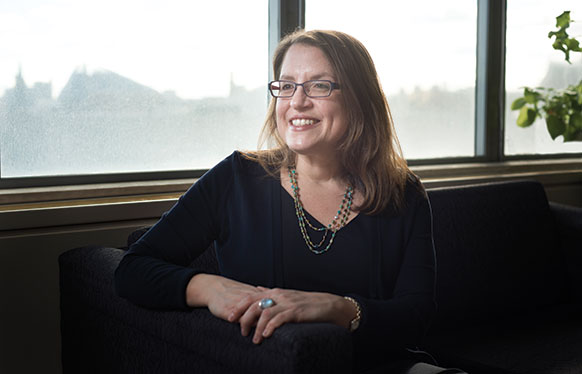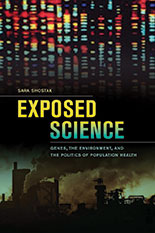
IRIS login | Reed College home Volume 94, No. 1: March 2015
Exposed Science

photo by ben gebo
Sara Shostak ’92 digs into the politics of public health
By James Helmsworth

Not long after Lula Bishop moved into Midway Village, a public housing project in Daly City, California, she developed scoliosis and rapidly gained weight. Her younger son got rashes on his knees where he had knelt in the dirt. Her oldest son went cross-eyed overnight. A brain tumor was pushing on his optic nerve.
They were hardly alone. Many neighbors were also suffering from a host of unexplained health issues, including cancer, seizures, infertility, and even death. They eventually discovered that Midway Village was built on soil contaminated by chemicals from an old PG&E gas-processing plant located nearby. In 1993, residents filed a class-action lawsuit against the federal government, blaming these chemicals for their illnesses. The federal government threw the case out. They sued PG&E and the San Mateo Housing Authority. Judges dismissed these cases, saying the residents didn’t demonstrate that pollution caused them to get sick. In 1999, dozens of the residents had their blood analyzed by a private medical clinic. The clinic found that the majority of them had “chromosome aberrations and irregularities.” But the chromosomal damage couldn’t be satisfactorily linked to chemical exposure. As of this writing, Midway is still accepting applications for housing from low-income residents of San Mateo County.
The controversy at Midway Village makes up one of the most vivid parts of Dr. Sara Shostak’s award-winning book, Exposed Science: Genes, the Environment, and the Politics of Population Health. Through rigorous analysis and interviews with scientists, regulators, and advocates, she makes the case that environmental health science, as a field, has structural vulnerabilities—vulnerabilities that some researchers have tried to address by focusing deep inside the human body, at the molecular level where genes and chemicals interact. Ironically, however, the focus on gene-environment interactions has had unintended consequences and may even put disadvantaged groups, like the low-income residents of Midway Village, at risk.
As useful as molecular-level research can be, Shostak contends that in many cases, there’s no need to wait for molecular-level data to take action to improve environmental health. “The research we need to identify precise biological mechanisms is not always the same as the research we need to motivate effective public health policy,” she says, “and focusing on the molecular level runs the risk of obfuscating the social, political, and economic factors that we already know shape people’s lives and life chances.”
Her fascination with sociology began at Reed, in the classroom of the late and legendary Prof. John Pock [sociology 1955-98], who is credited with launching the careers of more than 70 sociologists. Just a month into his year-long intro course, she knew that it was what she wanted to study. “It was just this incredibly exciting thing to discover that there was a systematic way of trying to understand this in the social world, and to analyze and come up with potential solutions for to address inequality.” Later she registered for a class on social stratification—required for all sociology majors—only to discover that she was the only student who had signed up. To her surprise, Pock decided to teach the course, anyway. For an entire semester, the pair met twice a week, together in a classroom by themselves. “I really had to be prepared,” she says
Shostak credits Reed with her passion for research. When she took statistics, students had to write their own computer programs. “There was no version of SPSS with pulldown menus then,” she says. “So, we would write out the code—I think it was in UNIX—and then we would have to wait for hours, most typically overnight for the analysis to run on the mainframe.” She continues, “So, on the one hand, it was excruciating—if you got something wrong in your coding, you would have to again wait for hours for a second run. But it was also thrilling for me, this sense that when I went to the computer lab in the morning, there could be an answer to a question that was important to me. I’m still motivated by that feeling—that we can ask important questions and find new answers. It’s a particular kind of creativity that is really compelling to me. And it’s something that I now try to impart to my students.”
But while many of Pock’s students went straight to grad school, Shostak had other plans. She was heavily involved with activism while on campus, particularly concerning violence against women and children, volunteering at shelters and on hotlines. After Reed, she did a stint as community organizer for HIV prevention in San Francisco. This drove her to attend a masters program in public health at UCLA. As a master’s student, she worked in health policy research, but eventually realized that she wanted to take a different route. “ I began to feel constrained by the limitation of receiving the questions of from others,” she says. “I started to wonder what it would look like to do research that steps back from the information needs of already defined policy debates and says ‘Well, wait a second, how do we do policy to begin with?’” she explains. So, in 1997, she moved to UCSF for a PhD program in sociology.
While she was in grad school, there was enormous scientific interest in the Human Genome Project. She became especially interested in the efforts of environmental health scientists who were beginning to mobilize their colleagues to support research on gene-environment interaction. Conceptualizing them as “strategic social actors,” a concept developed by Neil Fligstein ’73, she began to investigate the scientists’ strategies.
Shostak argues that these strategies have relied on what she calls a “consensus critique.” In order to circumvent the wide range of political and social differences among the actors in the field—researchers, activists, industry, and regulators—stakeholders build their conversations on concepts that they can agree on. What this usually means is focusing on the process of risk assessment and regulation. While this technique helps to resolve tensions in the field, Shostak points out that it does have some drawbacks—it downplays the social and economic factors that cause individuals to get sick. Thus, while environmental health scientists tend to see a genetic approach as means of increasing the certainty—and usability—of their research, environmental justice activists perceive research on gene-environment interaction as a smokescreen.
And that’s to say nothing of the way in which research has been shaped by the contentious politics of environmental regulation. Shostak worries about how the consensus critique actually obfuscates “the degree to which political and economically motivated interests have started to drive knowledge production in the environmental health sciences.”
It’s a well-founded worry. One researcher interviewed in Exposed Science described a kind of “cold war” between independent researchers and industry researchers, in which independent researchers continually found themselves refuting industry-sponsored work, only to have their own research refuted by a new industry study. Amid the political debates, the people that are hurt by toxic environments, such as the residents of Midway Village, get left behind.

LATEST COMMENTS
steve-jobs-1976 I knew Steve Jobs when he was on the second floor of Quincy. (Fall...
Utnapishtim - 2 weeks ago
Prof. Mason Drukman [political science 1964–70] This is gold, pure gold. God bless, Prof. Drukman.
puredog - 1 month ago
virginia-davis-1965 Such a good friend & compatriot in the day of Satyricon...
czarchasm - 4 months ago
John Peara Baba 1990 John died of a broken heart from losing his mom and then his...
kodachrome - 7 months ago
Carol Sawyer 1962 Who wrote this obit? I'm writing something about Carol Sawyer...
MsLaurie Pepper - 8 months ago
William W. Wissman MAT 1969 ...and THREE sisters. Sabra, the oldest, Mary, the middle, and...
riclf - 10 months ago